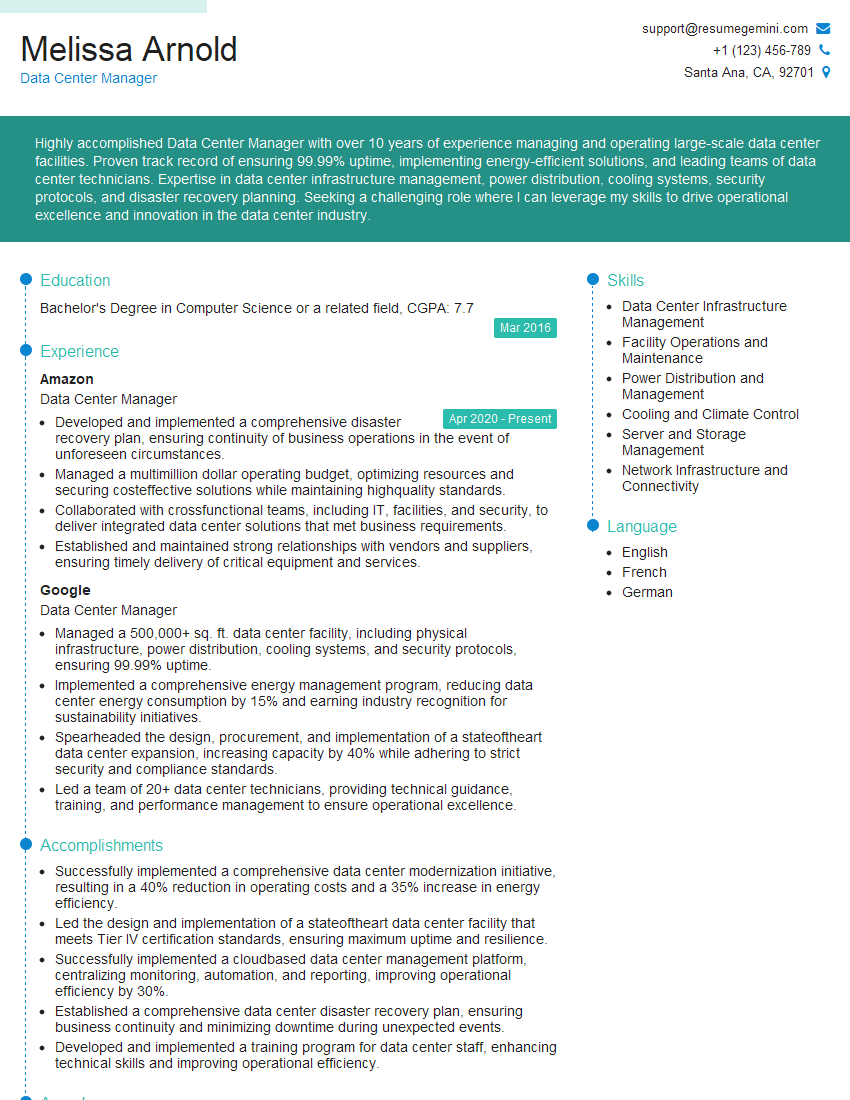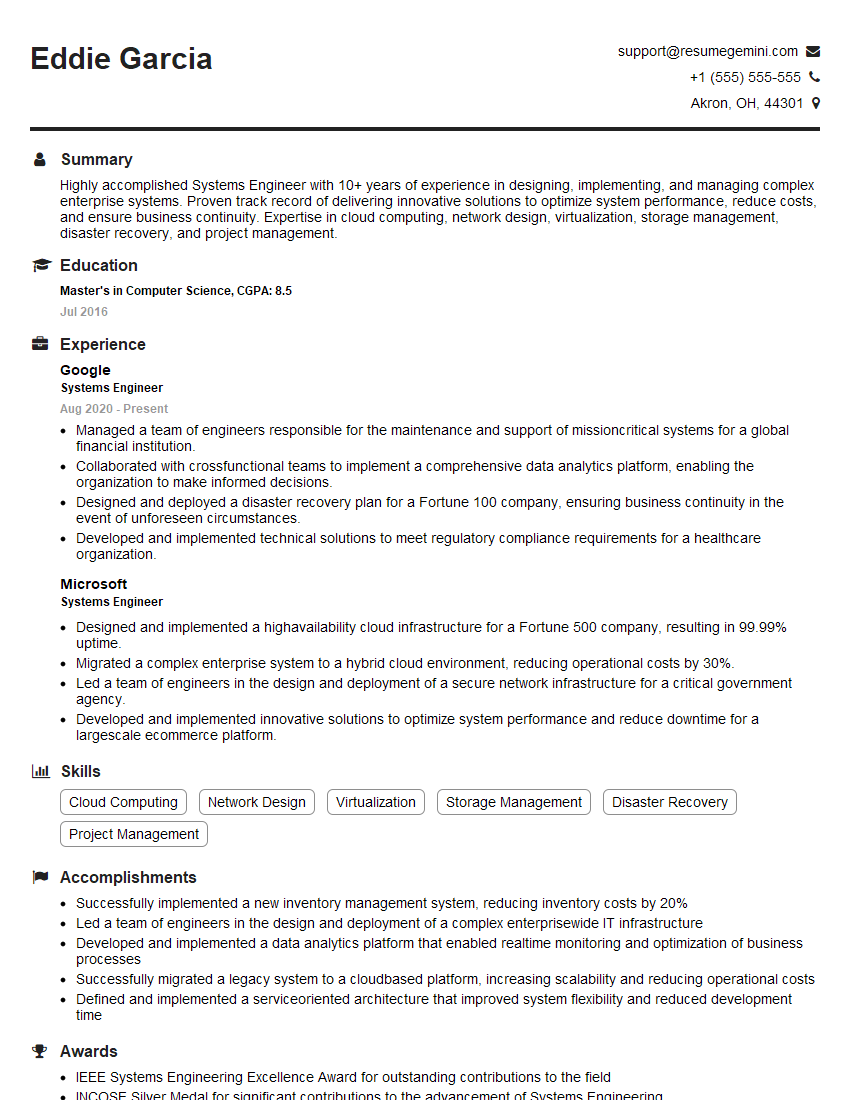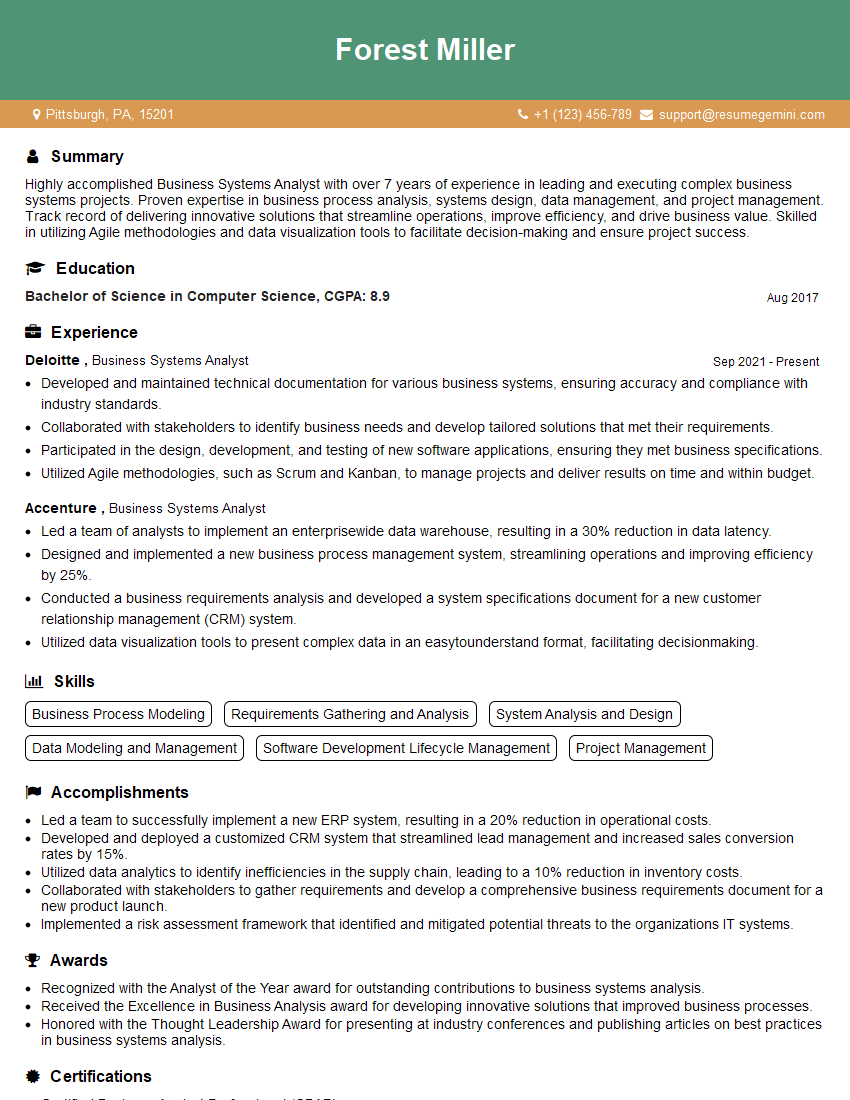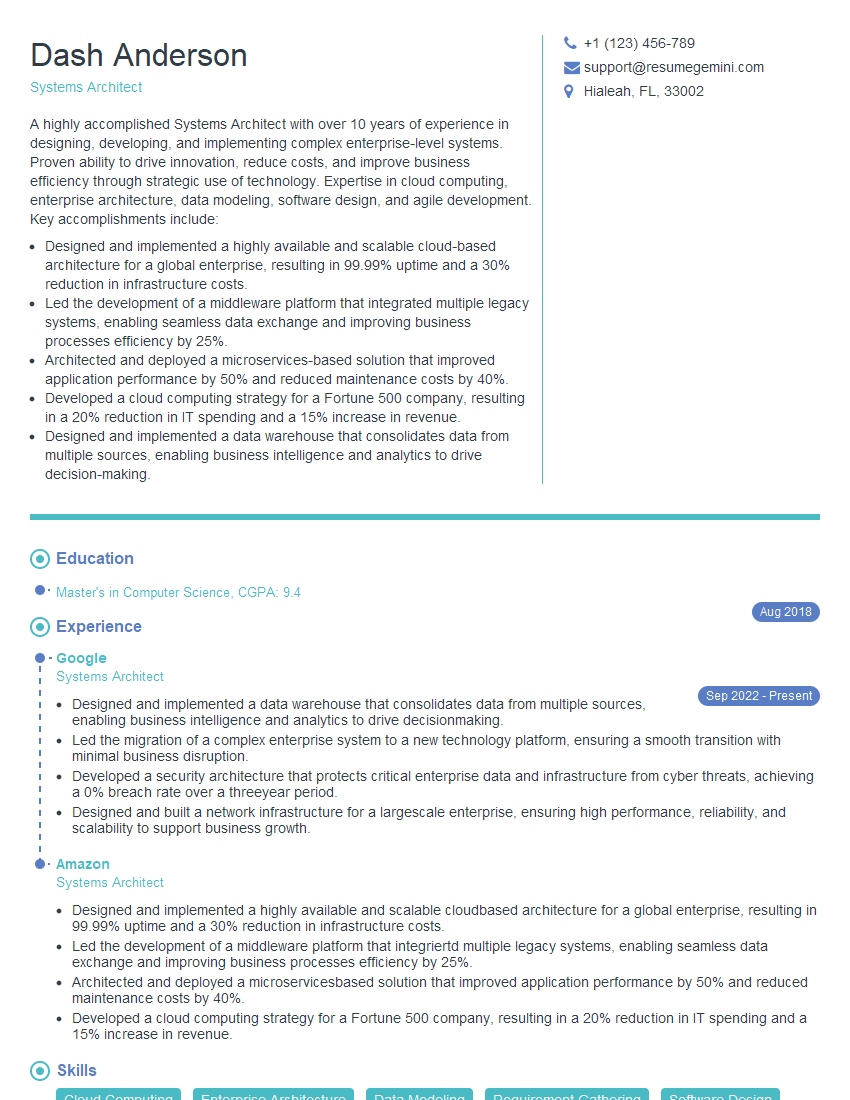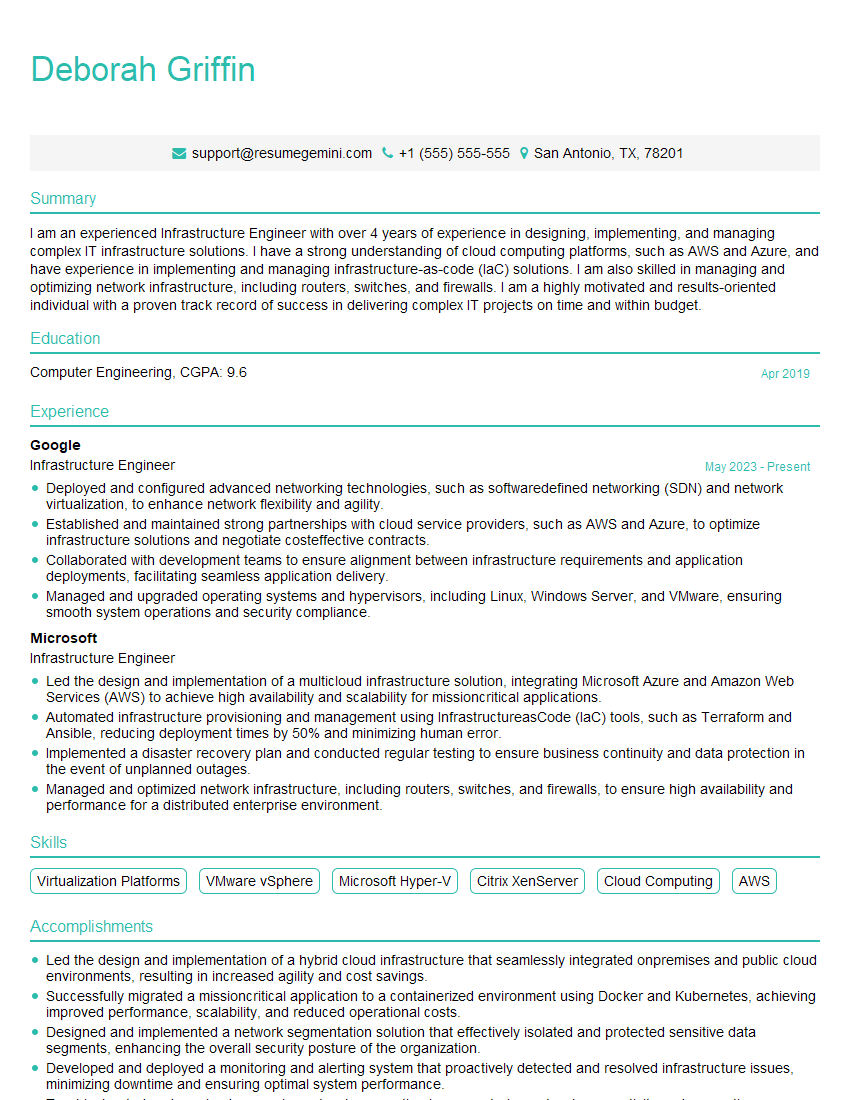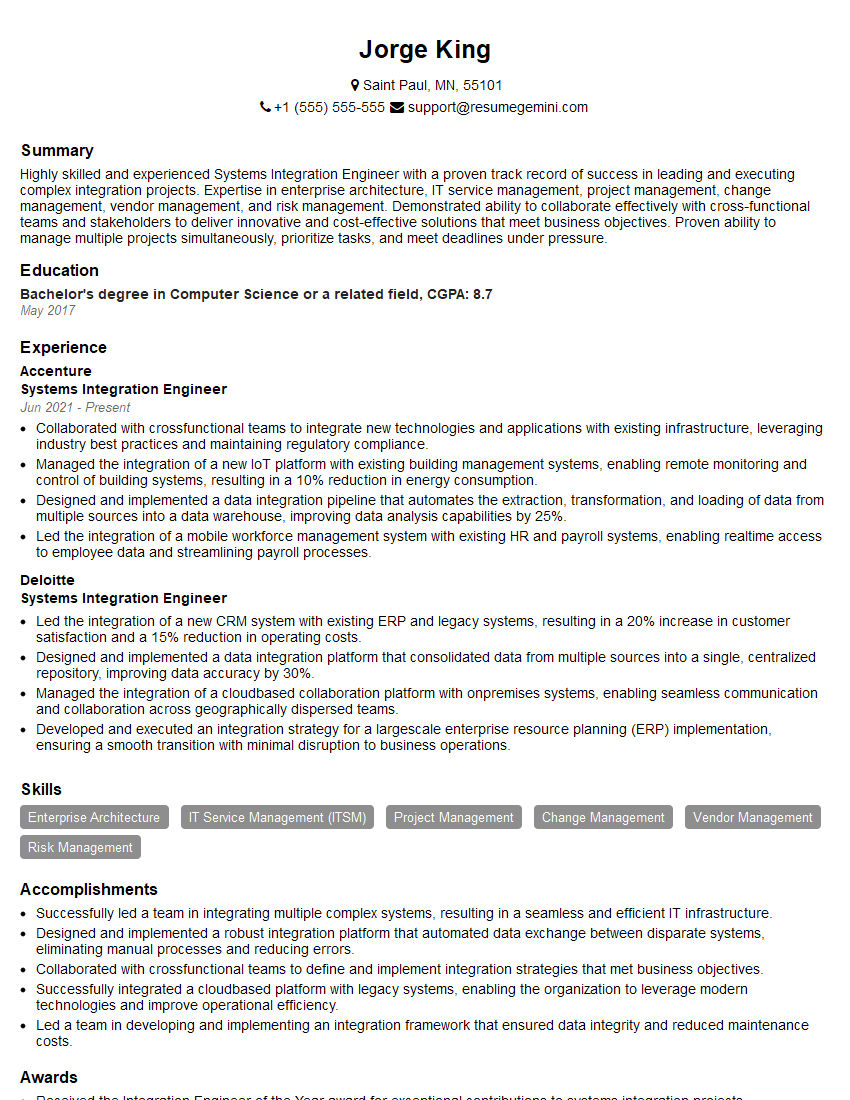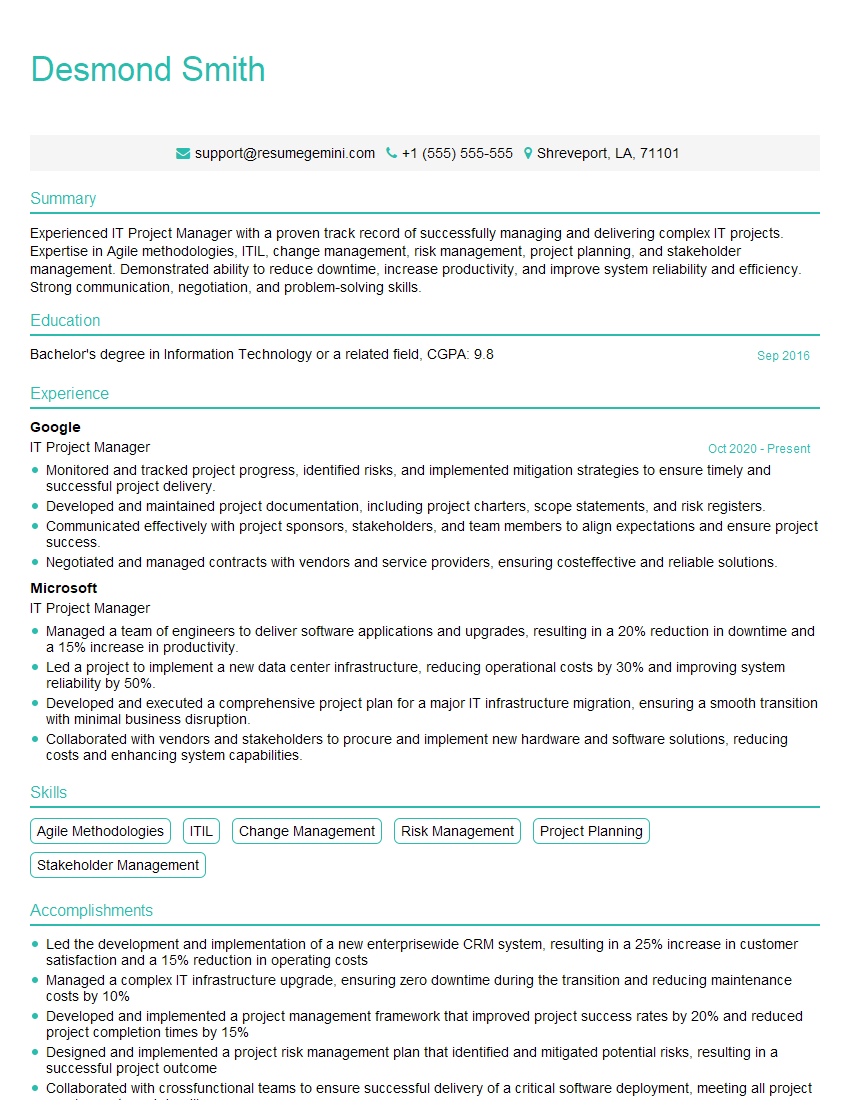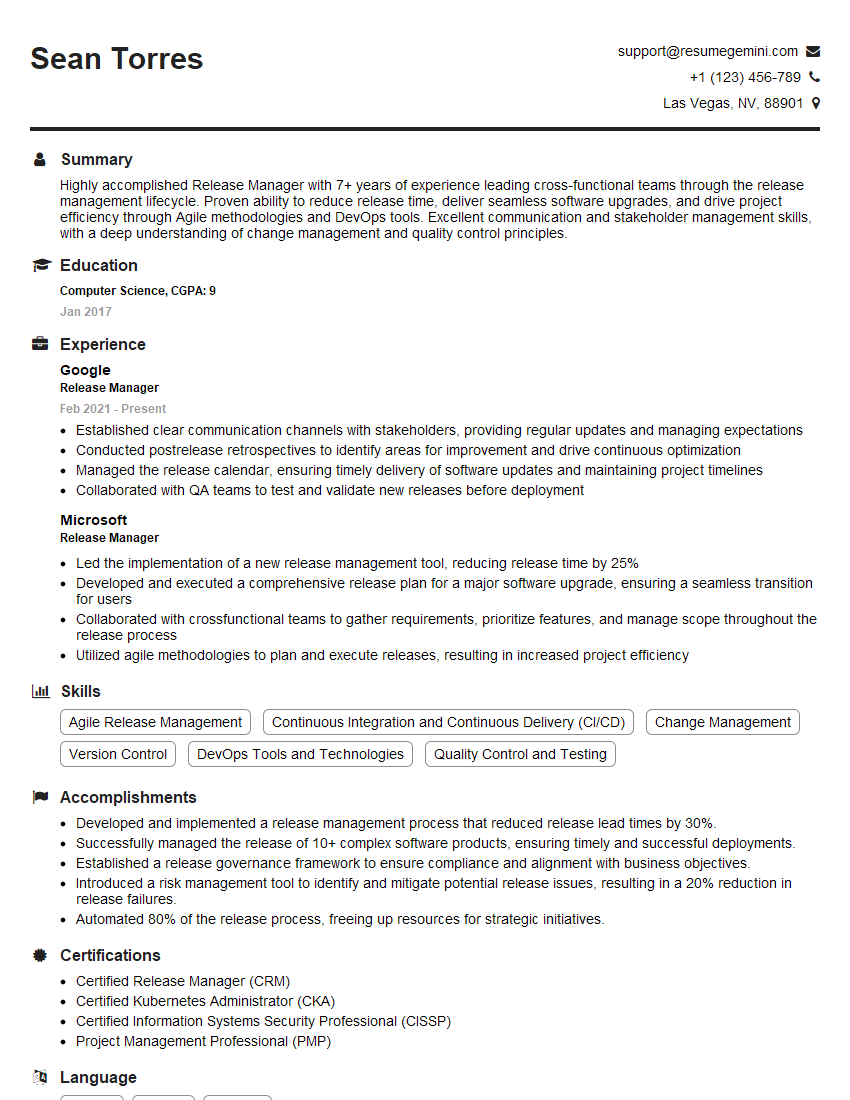Interviews are opportunities to demonstrate your expertise, and this guide is here to help you shine. Explore the essential Systems Engineering and Management interview questions that employers frequently ask, paired with strategies for crafting responses that set you apart from the competition.
Questions Asked in Systems Engineering and Management Interview
Q 1. Explain the difference between Waterfall and Agile methodologies in systems engineering.
Waterfall and Agile are two contrasting approaches to systems engineering. Waterfall is a linear, sequential process where each phase (requirements, design, implementation, testing, deployment, maintenance) must be completed before the next begins. Think of it like building a brick wall – you can’t start laying the next row until the previous one is firmly in place. This approach is well-suited for projects with stable requirements and minimal expected changes.
Agile, on the other hand, is an iterative and incremental approach. It emphasizes flexibility and collaboration, breaking the project into smaller, manageable iterations (sprints) with frequent feedback loops. Each sprint produces a working increment of the system. Imagine building with LEGOs – you can constantly adjust and improve your design as you go, incorporating feedback along the way. This works best for projects with evolving requirements or where early user feedback is crucial.
- Waterfall Strengths: Simple to understand, well-defined stages, easy to manage budget and timelines (initially).
- Waterfall Weaknesses: Inflexible, late detection of errors, limited client involvement until late stages.
- Agile Strengths: Adaptable to change, frequent feedback loops, faster time to market for core functionalities.
- Agile Weaknesses: Can be challenging to manage in large, complex projects, requires a highly collaborative team.
The best choice depends entirely on the project’s context. For example, developing a mission-critical embedded system with stringent safety requirements might benefit from a more structured Waterfall approach, while building a web application with a fast-paced, evolving market would be better suited to Agile.
Q 2. Describe your experience with requirements gathering and analysis.
My experience in requirements gathering and analysis involves a multifaceted approach. I begin by actively engaging stakeholders – including clients, users, and subject matter experts – using various techniques like interviews, workshops, surveys, and document analysis. This helps me gain a comprehensive understanding of their needs and expectations. I strive to elicit both functional (what the system should do) and non-functional (performance, security, usability) requirements.
A key aspect is translating these often vague requirements into clear, concise, and testable statements. I utilize tools like use cases, user stories (as in Agile), and data flow diagrams to model the system’s behavior and data flow. I also employ techniques like requirements traceability matrices to ensure that every requirement is linked to design, implementation, and testing activities. This ensures that nothing is overlooked and facilitates change management throughout the project lifecycle.
For example, in a recent project involving the development of a medical device software, I conducted extensive interviews with physicians and nurses to understand their workflow and identify their specific needs. This resulted in a detailed requirements document that accurately captured the functionalities, performance criteria, and regulatory compliance necessities. This careful analysis prevented costly rework later in the project lifecycle.
Q 3. How do you handle conflicting priorities in a project?
Conflicting priorities are inevitable in project management. My approach involves a structured process to resolve them effectively. First, I clearly identify and document all conflicting priorities. Then, I engage stakeholders in a collaborative prioritization exercise. This might involve techniques like scoring matrices, where each priority is scored based on factors like importance, urgency, and risk. We then discuss the trade-offs associated with each option.
Sometimes, negotiation and compromise are necessary. We might identify creative solutions that allow us to address as many priorities as possible without sacrificing the overall project goals. In some cases, we might need to re-evaluate the project scope or timeline to better accommodate the priorities. Transparency and open communication are critical during this process, ensuring all stakeholders understand the rationale behind the final decision.
For instance, in a past project with limited budget and a tight deadline, we faced conflicting priorities between adding a new feature and ensuring the stability of the existing system. Through a structured prioritization exercise, we decided to postpone the new feature to the next release, ensuring the stability of the current release remained the highest priority. This decision was communicated clearly to the stakeholders, mitigating potential conflict.
Q 4. What are your preferred methods for risk management in a system implementation?
My preferred methods for risk management encompass a proactive and iterative approach. I begin with risk identification, using techniques like brainstorming, checklists, and SWOT analysis to identify potential threats and opportunities. Once identified, I assess the likelihood and impact of each risk, using qualitative or quantitative methods to prioritize them. This often involves creating a risk register – a document detailing each identified risk, its probability, its potential impact, and mitigation strategies.
Next, I develop mitigation strategies for high-priority risks. These strategies might involve contingency plans, risk avoidance (eliminating the risk entirely), risk transfer (insuring against the risk), risk reduction (minimizing the likelihood or impact), or risk acceptance (acknowledging the risk and monitoring it closely). Throughout the project, I regularly monitor and reassess risks, updating the risk register as needed. This ensures that the project remains adaptable to changing circumstances.
For example, in a project involving the deployment of a new software system, we identified the risk of data loss due to a system failure. Our mitigation strategy involved implementing regular data backups, employing redundancy in our infrastructure, and conducting rigorous testing before deployment. This proactive approach prevented any significant disruptions due to potential system failures.
Q 5. Explain your experience with system design and architecture.
My experience in system design and architecture includes a deep understanding of various architectural patterns and design principles. I start by defining the system’s overall architecture, considering factors like scalability, performance, security, and maintainability. I utilize modeling tools like UML (Unified Modeling Language) to create diagrams that visualize the system’s structure, components, and interactions. This ensures a clear understanding and effective communication among the development team.
I am proficient in various architectural styles, including microservices, layered architectures, and event-driven architectures. The choice of architecture depends heavily on the specific project requirements. For instance, a microservices architecture might be ideal for a large, complex system requiring high scalability and flexibility, whereas a layered architecture might be suitable for smaller systems with well-defined layers of functionality.
In one project, I designed a highly scalable cloud-based architecture for a large e-commerce platform. We used a microservices architecture to ensure independent deployment and scaling of individual services. This architecture allowed us to handle peak traffic loads during promotional events without significant performance degradation, resulting in a significant increase in customer satisfaction and sales.
Q 6. Describe a time you had to troubleshoot a complex system failure.
During a project involving a large-scale data processing pipeline, we experienced a sudden and complete system failure. My role involved leading the troubleshooting efforts. First, I gathered information from various sources, including system logs, monitoring tools, and team members. I organized the information logically, focusing on identifying the root cause of the failure. We used a structured approach, starting with the most likely causes and working our way through potential issues.
Using our monitoring tools, we identified a bottleneck in a specific component of the pipeline, leading to a cascading failure across the entire system. Through rigorous debugging and analysis of the code and system logs, we pinpointed the specific line of code causing the issue. The issue was due to an unexpected data format, which the system wasn’t prepared to handle. We immediately rolled back to the previous stable version of the software while deploying a fix.
This experience highlighted the importance of robust logging, comprehensive monitoring, and a well-defined incident response plan. We implemented improved error handling and added more sophisticated monitoring to prevent similar issues in the future.
Q 7. How do you ensure system security and compliance?
Ensuring system security and compliance is paramount. My approach involves implementing security best practices throughout the entire system lifecycle. This starts with incorporating security requirements from the very beginning of the project, ensuring that security is not an afterthought. I utilize secure coding practices, vulnerability scanning tools, and penetration testing to identify and address security vulnerabilities.
Compliance is addressed through adherence to relevant regulations and standards, such as ISO 27001 (information security management), HIPAA (health information privacy), or GDPR (data protection). I ensure that the system design and implementation meet these requirements, documenting all security controls and processes. Regular security audits and vulnerability assessments are conducted to verify the system’s security posture and identify any weaknesses.
For example, in a healthcare project, we implemented robust authentication and authorization mechanisms, data encryption both in transit and at rest, and access controls to ensure HIPAA compliance. We also conducted regular security audits and penetration testing to identify and address any security vulnerabilities, ensuring patient data privacy and security.
Q 8. What experience do you have with cloud computing platforms (AWS, Azure, GCP)?
My experience with cloud computing platforms spans several years and encompasses all three major providers: AWS, Azure, and GCP. I’ve worked extensively with each, leveraging their strengths for different projects. For instance, on a recent project requiring high scalability and cost-effectiveness, we chose AWS for its robust EC2 instances and auto-scaling capabilities. This allowed us to dynamically adjust resources based on real-time demand, avoiding unnecessary expenses. In another project demanding robust data analytics and machine learning capabilities, Azure’s integrated services proved invaluable, particularly its Azure Machine Learning Studio. Finally, GCP’s strengths in big data processing, using services like BigQuery, were instrumental in a project involving the analysis of a massive dataset. My experience isn’t limited to just using the core compute services; I’m also proficient with their respective databases (RDS, Azure SQL Database, Cloud SQL), storage services (S3, Azure Blob Storage, Cloud Storage), and networking components (VPC, Virtual Networks, VPC). This diverse experience allows me to choose the optimal platform based on project requirements and ensures I can efficiently manage infrastructure in the cloud.
Q 9. How do you manage stakeholder expectations?
Managing stakeholder expectations is crucial for project success. I approach it proactively and transparently. Firstly, I ensure clear communication from the outset. This involves defining project goals, timelines, and deliverables in a shared document, accessible to all stakeholders. Regular updates, using various communication channels (email, meetings, project management software), keep everyone informed about progress and potential roadblocks. I use visual tools like Gantt charts and burn-down charts to illustrate progress and forecast completion. Crucially, I actively solicit feedback and address concerns promptly. For example, if a change request impacts the timeline, I present the stakeholders with a revised schedule and discuss the trade-offs. Transparency and proactive communication are key to managing expectations and ensuring that everyone is on the same page. I consider managing stakeholder expectations to be an ongoing iterative process requiring consistent communication and mutual understanding.
Q 10. Describe your experience with system testing and validation.
My system testing and validation experience encompasses a wide range of methodologies, from unit testing to integration testing and system-level validation. I’m proficient in various testing techniques, including black-box, white-box, and grey-box testing. I usually employ a phased approach, beginning with unit tests to verify individual components, followed by integration tests to ensure seamless communication between modules. System-level tests verify overall system functionality and performance. I always create comprehensive test plans and test cases, making sure to cover positive and negative scenarios. For instance, in a recent project involving a critical financial application, we implemented rigorous testing, including load testing to simulate high-volume transactions, and security testing to identify vulnerabilities. We used automated testing tools wherever possible, significantly speeding up the testing process and improving consistency. The validation phase includes formal acceptance testing with the stakeholders to ensure the system meets their requirements and expectations. Documentation of all test results and any identified defects is crucial and forms the foundation for continuous improvement and future iterations.
Q 11. What are your preferred methods for system monitoring and performance tuning?
My preferred methods for system monitoring and performance tuning are multifaceted and depend on the specific system and its requirements. I typically use a combination of tools and strategies. For monitoring, I leverage centralized monitoring systems such as Nagios, Prometheus, or Datadog, which provide real-time insights into system health, resource utilization, and performance metrics. These tools allow us to set alerts for critical thresholds, enabling proactive intervention. For performance tuning, I use profiling tools to identify bottlenecks and optimize code. This often involves analyzing system logs, examining resource usage (CPU, memory, disk I/O), and optimizing database queries. In one project, we used profiling tools to identify a specific function that was consuming excessive CPU resources. After optimization, system response time improved significantly. I also advocate for performance testing as a preventative measure, conducting load tests and stress tests to identify performance limitations before they become operational problems. Regular performance reviews and capacity planning are integral parts of this continuous improvement process.
Q 12. Explain your experience with capacity planning and resource allocation.
Capacity planning and resource allocation are critical for ensuring system stability and performance. My approach involves a thorough understanding of current and projected workloads, anticipated growth, and resource requirements. This typically begins with detailed analysis of historical data, forecasting future needs based on trends and business requirements. I use various capacity planning tools and techniques, including statistical modeling and simulation, to project future resource demands. This allows me to make informed decisions regarding resource provisioning, including hardware (servers, storage), software licenses, and network bandwidth. Resource allocation involves strategically distributing resources to different parts of the system to optimize performance and efficiency. For example, in a recent project, we used a queuing system to manage incoming requests, ensuring that resources were allocated efficiently during periods of high demand. Continuous monitoring and adjustments based on real-time data are essential to ensure that resource allocation remains optimized. Regularly reviewing and updating the capacity plan is vital to address evolving business needs and system growth.
Q 13. How do you handle change requests during a project?
Handling change requests during a project requires a structured and controlled approach. Firstly, all change requests are documented and evaluated using a formal change management process. This typically involves a Change Request Form which details the request, its impact, and the proposed solution. The impact assessment considers technical feasibility, cost, and schedule implications. We use a change control board (CCB) which reviews and approves or rejects change requests. Approved requests are incorporated into the project plan, with updated timelines and resource allocation. Transparency is key here – stakeholders are informed of any changes and their potential impact. Unforeseen changes that could impact deadlines or budget are discussed openly and solutions are collaboratively developed. Effective communication, a clear change management process, and the use of project management tools are essential to managing changes efficiently and minimizing disruption to the project timeline and budget.
Q 14. Describe your experience with system documentation and knowledge transfer.
Comprehensive system documentation and knowledge transfer are vital for long-term system maintainability and operational efficiency. My approach emphasizes creating clear, concise, and up-to-date documentation, encompassing system architecture, design specifications, operational procedures, and troubleshooting guides. I use various tools and formats, including wikis, version control systems (like Git), and diagramming software. Knowledge transfer is an ongoing process that starts early in the project. Regular team meetings, code reviews, and knowledge-sharing sessions are essential. I also create training materials and documentation specifically for system users and administrators. For example, I created a detailed user manual and a series of video tutorials for a recent project, ensuring that even users with limited technical experience could effectively use the system. Properly documented systems and comprehensive knowledge transfer minimize disruption during staff changes, facilitating seamless system maintenance and support, thereby reducing downtime and maintaining operational efficiency.
Q 15. Explain your understanding of different system architectures (e.g., microservices, monolithic).
System architectures define how a system’s components are organized and interact. Two prominent examples are monolithic and microservices architectures. A monolithic architecture is like a single, large apartment building: all functionalities are bundled together within a single application. This simplifies development and deployment initially, but scaling and maintaining it becomes challenging as it grows. Changes require updating the entire application, leading to longer deployment cycles and increased risk.
In contrast, a microservices architecture is more like a complex of smaller, independent buildings. Each building (microservice) handles a specific function, communicating with others through well-defined interfaces (APIs). This modular design allows for independent scaling, deployment, and updates, making it more resilient and adaptable to change. For example, in an e-commerce platform, one microservice might handle user authentication, another product catalog, and another order processing, each operating independently. The choice between monolithic and microservices depends on factors like project size, complexity, and team structure. Small projects might benefit from the simplicity of a monolithic architecture, while large, complex projects often necessitate the flexibility of microservices.
Career Expert Tips:
- Ace those interviews! Prepare effectively by reviewing the Top 50 Most Common Interview Questions on ResumeGemini.
- Navigate your job search with confidence! Explore a wide range of Career Tips on ResumeGemini. Learn about common challenges and recommendations to overcome them.
- Craft the perfect resume! Master the Art of Resume Writing with ResumeGemini’s guide. Showcase your unique qualifications and achievements effectively.
- Don’t miss out on holiday savings! Build your dream resume with ResumeGemini’s ATS optimized templates.
Q 16. What metrics do you use to measure system performance?
Measuring system performance requires a multi-faceted approach, looking at both quantitative and qualitative metrics. Key quantitative metrics include:
- Response time/Latency: How long it takes for the system to respond to a request. Lower is better.
- Throughput: The number of requests processed per unit of time. Higher is better.
- Resource utilization (CPU, Memory, Disk I/O): How efficiently the system uses its resources. Optimally, utilization should be high but not exceeding capacity.
- Error rate: The percentage of requests that fail. Lower is better.
Qualitative metrics are equally important, including:
- User experience (UX): How easily and pleasantly users can interact with the system.
- Scalability: The system’s ability to handle increasing workloads.
- Reliability: The system’s ability to remain operational and provide consistent service.
- Maintainability: How easy it is to understand, modify, and maintain the system.
The specific metrics chosen depend on the system’s purpose and critical functionalities. For example, a real-time trading system might prioritize response time and throughput above all else, while an email server might focus on reliability and scalability.
Q 17. How do you balance innovation with stability in system design?
Balancing innovation and stability in system design is crucial for long-term success. Think of it like building a house: you need a strong foundation (stability) before you can add exciting features (innovation). A robust, well-tested foundation ensures the system can handle unexpected issues, while carefully planned innovation enhances functionality and user experience.
Here’s a practical approach:
- Iterative development: Implement changes incrementally, testing thoroughly at each stage. This minimizes the risk of large-scale failures.
- Feature flags/toggles: Enable or disable new features without deploying a new version. This allows quick rollback if issues arise.
- A/B testing: Compare different versions of a feature to determine which performs best. This allows data-driven decisions about innovation.
- Continuous integration/continuous deployment (CI/CD): Automates the build, test, and deployment process, ensuring rapid and reliable releases.
- Monitoring and logging: Constantly monitor system performance and collect logs to identify and address potential problems early.
This balanced approach allows for the introduction of new features while maintaining system stability and minimizing disruption.
Q 18. Describe your experience with DevOps principles and practices.
DevOps principles and practices are fundamental to modern system engineering and management. My experience encompasses the entire DevOps lifecycle, from development to deployment and beyond. I’ve worked extensively with tools such as Git for version control, Jenkins for continuous integration, Docker for containerization, and Kubernetes for orchestration. I understand the importance of automation, collaboration, and continuous improvement in delivering high-quality software.
For instance, in a previous project, we implemented a CI/CD pipeline that automated the build, testing, and deployment processes. This reduced deployment time from days to hours, enabling faster iteration cycles and quicker responses to user feedback. We also embraced infrastructure as code (IaC) using tools like Terraform to manage and provision our infrastructure in a repeatable and reliable manner. This ensured consistency across different environments and simplified infrastructure management.
Q 19. What is your approach to problem-solving in a complex system environment?
Problem-solving in complex systems requires a systematic approach. I typically follow these steps:
- Identify the problem: Clearly define the issue, collecting relevant data and logs. This often involves analyzing monitoring metrics and user reports.
- Isolate the root cause: Use debugging techniques, tracing logs, and analyzing system behavior to identify the source of the problem. This might involve working with other teams or using specialized tools.
- Develop a solution: Design a fix that addresses the root cause, considering its impact on other system components. This often involves trade-off analysis and prioritizing solutions based on impact and feasibility.
- Implement and test the solution: Implement the fix, testing it thoroughly in a controlled environment before deploying to production. This often involves automated testing and regression testing.
- Monitor and evaluate: After deploying the solution, continuously monitor the system to ensure the problem is resolved and that the fix doesn’t introduce new issues.
Throughout this process, clear communication and collaboration with the team are essential to ensure everyone is aligned and informed.
Q 20. How do you prioritize tasks in a high-pressure environment?
Prioritizing tasks in a high-pressure environment requires a clear understanding of priorities and efficient time management. I use a combination of techniques including:
- MoSCoW method: Categorize tasks as Must have, Should have, Could have, and Won’t have. This clearly defines priorities and allows for focusing on the most critical tasks first.
- Eisenhower Matrix (Urgent/Important): Prioritize tasks based on their urgency and importance. This helps focus on high-impact tasks while delegating or delaying less critical ones.
- Risk assessment: Identify tasks with the highest potential negative impact if delayed, prioritizing these tasks accordingly.
- Timeboxing: Allocate specific time blocks for each task, forcing focus and promoting efficient use of time.
In addition to these techniques, maintaining clear communication with stakeholders and proactively managing expectations are crucial for effective task prioritization under pressure.
Q 21. Describe your experience with system integration and testing.
System integration and testing are critical for ensuring the smooth operation of a system. My experience covers various integration methods, including:
- API integration: Integrating different systems through well-defined APIs. This allows for flexible and scalable integration, enabling independent development and deployment of different components.
- Message queues: Using message queues (e.g., RabbitMQ, Kafka) for asynchronous communication between systems. This ensures loose coupling and enhances system resilience.
- Database integration: Integrating systems through shared databases or database replication. This approach requires careful consideration of data consistency and concurrency control.
Testing is an equally crucial aspect. I utilize various testing methodologies, including:
- Unit testing: Testing individual components in isolation.
- Integration testing: Testing the interactions between different components.
- System testing: Testing the entire system as a whole.
- Performance testing: Assessing the system’s performance under various loads.
- Security testing: Identifying and mitigating security vulnerabilities.
A thorough testing strategy is vital for identifying and resolving integration issues before deployment, reducing the risk of failures in production.
Q 22. What is your experience with configuration management tools?
Configuration management tools are crucial for tracking and managing changes to systems. They ensure consistency, reduce errors, and improve reproducibility. My experience spans several leading tools. For instance, I’ve extensively used Ansible for automating infrastructure provisioning and configuration management across various environments, from on-premise data centers to cloud-based deployments. Ansible’s agentless architecture and declarative approach made it ideal for managing a large fleet of servers, ensuring consistent configurations and minimizing manual intervention. I’ve also worked with Puppet, a powerful tool for managing complex infrastructure, and Chef, known for its robust infrastructure-as-code capabilities. Each tool has its strengths; choosing the right one depends on the specific project requirements and existing infrastructure. For example, while Puppet excels in managing large, complex environments, Ansible might be preferred for its ease of use and simpler learning curve in smaller projects. I’m comfortable adapting to different tools and selecting the optimal solution for the task at hand.
In one project involving a microservices architecture, I used Ansible to automate the deployment and configuration of dozens of containers across multiple cloud providers. This ensured consistency in deployments and reduced the risk of human error, significantly improving the efficiency and reliability of our CI/CD pipeline.
Q 23. How do you ensure system scalability and maintainability?
Ensuring system scalability and maintainability requires a multifaceted approach, focusing on architecture, design choices, and operational practices. Scalability means the system can handle increasing workloads without significant performance degradation. Maintainability refers to the ease with which the system can be modified, upgraded, and debugged. These two goals often go hand-in-hand.
- Modular Design: Breaking down the system into independent, reusable modules makes it easier to scale specific components and simplifies maintenance. Changes to one module have minimal impact on others.
- Horizontal Scaling: Instead of scaling vertically (increasing the power of individual servers), we often utilize horizontal scaling, adding more servers to the pool. This improves availability and resilience.
- Load Balancing: Distributing incoming traffic across multiple servers prevents any single server from becoming overloaded.
- Automated Testing: Comprehensive testing throughout the development lifecycle (unit, integration, system) helps to identify and address issues early, reducing maintenance costs.
- Infrastructure as Code (IaC): Managing infrastructure through code (tools like Terraform or CloudFormation) allows for reproducible, consistent deployments and simplifies scaling. Changes are version-controlled, auditable, and easily reversible.
- Monitoring and Logging: Robust monitoring and logging tools allow us to identify bottlenecks, potential problems, and areas for optimization. This helps proactive maintenance and efficient issue resolution.
In a previous role, we migrated a monolithic application to a microservices architecture. This improved scalability significantly, allowing individual services to be scaled independently based on demand. The modular design also made maintenance much easier, as teams could work on individual services without impacting others.
Q 24. Describe your experience with version control systems (e.g., Git).
Version control systems, like Git, are fundamental to collaborative software development and system management. They track changes to code, configuration files, and other artifacts, allowing for easy rollback, collaboration, and efficient management of different versions. My experience with Git includes branching strategies (like Gitflow), merging, resolving conflicts, and using platforms like GitHub and GitLab for code repositories and collaborative workflows. I understand the importance of creating meaningful commit messages, adhering to branching conventions, and conducting code reviews.
I’ve utilized Git extensively for managing infrastructure-as-code, ensuring that every change to the infrastructure is tracked and auditable. This significantly reduces the risk of errors and allows for easy rollback in case of problems. For example, I’ve used Git to manage Terraform configurations, ensuring that any changes to cloud infrastructure are tracked and can be reliably recreated.
git checkout -b feature/new-module This command creates a new branch for developing a new module, ensuring that the main branch remains stable.
Q 25. What is your experience with incident management and resolution?
Incident management involves the identification, analysis, resolution, and follow-up of system problems. My approach uses a structured framework like ITIL (Information Technology Infrastructure Library) or similar best practices. This generally includes the following steps:
- Incident Identification and Logging: Clearly documenting the incident, its impact, and initial symptoms.
- Categorization and Prioritization: Classifying incidents based on severity and impact to determine urgency of resolution.
- Diagnosis and Resolution: Investigating the root cause and implementing a solution. This often involves collaboration with various teams.
- Communication and Updates: Keeping stakeholders informed throughout the process.
- Post-Incident Review: Analyzing the incident to identify areas for improvement and prevent recurrence.
In a past incident involving a database outage, we used our incident management process to quickly isolate the problem (a faulty network switch), restore service, and implement preventative measures to avoid similar issues in the future. This involved close collaboration between the database administration, network engineering, and application development teams.
Q 26. How do you utilize data analytics to improve system performance?
Data analytics plays a vital role in improving system performance. By analyzing system logs, monitoring metrics, and other performance data, we can identify bottlenecks, optimize resource utilization, and proactively address potential problems. Tools like Grafana, Prometheus, and ELK stack are frequently used for this purpose. My approach typically involves:
- Defining Key Performance Indicators (KPIs): Identifying the critical metrics that reflect system health and performance.
- Data Collection: Gathering relevant data from various sources, including system logs, monitoring tools, and application performance monitoring (APM) systems.
- Data Analysis: Using statistical methods and visualization tools to identify trends, anomalies, and patterns in the data.
- Root Cause Analysis: Investigating the underlying causes of performance issues.
- Optimization and Improvement: Implementing changes based on the analysis to improve system performance, scalability, and reliability.
In one project, we used data analytics to identify a memory leak in a key application. This was done by analyzing system logs and memory usage metrics, which revealed a steady increase in memory consumption over time. By addressing the memory leak, we significantly improved the application’s performance and stability.
Q 27. Describe your experience with automation and scripting.
Automation and scripting are essential for streamlining system administration, improving efficiency, and reducing errors. My expertise includes various scripting languages such as Python, Bash, and PowerShell, and I have experience using automation tools like Ansible, Chef, and Puppet (as mentioned earlier). I leverage these skills to automate repetitive tasks, build CI/CD pipelines, and manage infrastructure.
Examples of my scripting work include creating automated backups, deploying applications, configuring servers, and monitoring system health. I have also developed custom scripts to integrate different systems and tools, improving overall workflow efficiency. For instance, I automated the process of provisioning new virtual machines in a cloud environment using a Python script that interacts with the cloud provider’s API. This eliminated manual intervention, reduced deployment time, and minimized the risk of human error.
# Python script snippet for automating server configuration import paramiko #Example library ssh = paramiko.SSHClient() ssh.set_missing_host_key_policy(paramiko.AutoAddPolicy()) ssh.connect(hostname, username, password) stdin, stdout, stderr = ssh.exec_command('sudo apt update && sudo apt upgrade -y') This snippet shows a basic example of using Python and Paramiko to remotely update packages on a Linux server. Error handling and more robust logic would be incorporated in a production environment.
Key Topics to Learn for Systems Engineering and Management Interview
- Systems Thinking & Modeling: Understanding complex systems, identifying interdependencies, and utilizing modeling techniques (e.g., UML, SysML) to represent system behavior and architecture. Practical application: Analyzing a system’s performance and proposing improvements based on model-driven insights.
- Requirements Engineering: Eliciting, analyzing, specifying, and validating system requirements. Practical application: Developing a clear and concise requirements document for a new software system, ensuring stakeholder alignment.
- System Design & Architecture: Designing robust, scalable, and maintainable systems considering various architectural patterns (e.g., microservices, layered architecture). Practical application: Choosing the right architecture for a specific project based on its constraints and objectives.
- Risk Management & Mitigation: Identifying, assessing, and mitigating potential risks throughout the system lifecycle. Practical application: Developing a risk mitigation plan for a critical project, prioritizing mitigation efforts based on impact and likelihood.
- Project Management & Planning: Applying project management methodologies (e.g., Agile, Waterfall) to manage system development projects effectively. Practical application: Developing a realistic project schedule and budget, tracking progress, and managing resources.
- Testing & Verification: Developing and executing test plans to ensure system functionality and quality. Practical application: Designing effective test cases to verify system requirements and identify defects.
- Configuration Management: Managing system configurations and changes throughout the lifecycle. Practical application: Implementing a version control system and change management process to maintain system integrity.
- Technical Communication & Collaboration: Effectively communicating technical information to both technical and non-technical audiences. Practical application: Presenting project status updates to stakeholders, documenting system design and processes clearly.
Next Steps
Mastering Systems Engineering and Management principles is crucial for career advancement, opening doors to leadership roles and high-impact projects. A well-crafted resume is your key to unlocking these opportunities. Focus on creating an ATS-friendly resume that highlights your skills and experience effectively. To enhance your resume-building experience and increase your chances of landing your dream job, we recommend using ResumeGemini. ResumeGemini provides a streamlined process for creating professional resumes, and we offer examples of resumes tailored to Systems Engineering and Management to help guide you.
Explore more articles
Users Rating of Our Blogs
Share Your Experience
We value your feedback! Please rate our content and share your thoughts (optional).
What Readers Say About Our Blog
good
